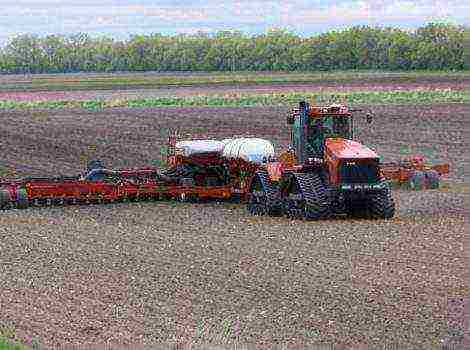Content
- 1 First step: choose the type of hydrangea
- 2 Tree hydrangea
- 3 Panicle hydrangea
- 4 Large-leaved hydrangea
- 5 Second step: decide on a reproduction method
- 6 Plant propagation by cuttings
- 7 Propagation of hydrangeas by seeds
- 8 Third step: choose a place on the site
- 9 Fourth step: plant hydrangea in the ground
- 10 Step Five: Watering Regularly
- 11 Sixth step: periodically loosen the soil
- 12 Seventh step: color the hydrangea
- 13 Eighth step: prune the plant
- 14 Ninth step: feed
- 15 Tenth step: cover the hydrangea for the winter
- 16 Site selection and soil preparation
- 17 Planting hydrangeas outdoors
- 18 Top dressing and mulching as the basis of care
- 19 Pruning hydrangeas - continue to groom
- 20 Preparing for landing
- 21 Planting hydrangeas
- 22 Hydrangea care
- 23 Types of hydrangea
- 24 How to plant correctly
- 25 Plant care
- 26 Cuttings
Any suburban area will be transformed beyond recognition for the better if it is refined with plantings of magnificent hydrangea. This plant is unpretentious, demonstrates lush and bright flowering, therefore it is popular with many flower growers. Practice shows that growing beautiful bushes in the open field is a simple and easy task. However, knowledge of the nuances and features will save you from mistakes and the death of bushes. Consider how to care for a hydrangea in the country, so that it arouses pride in its work and envy of neighbors.
First step: choose the type of hydrangea
In fact, the family of hydrangea flowers is quite extensive. Most often, deciduous species are cultivated. They feel great outdoors in the Russian climate. There are also a lot of varieties, as well as species. For planting in the country or in the garden, large-leaved (willow), paniculate and tree hydrangea are recommended. They are very beautiful, take root well and practically do not bring problems. However, before caring for a tree-like, large-leaved or panicle hydrangea in the country, you need to familiarize yourself with their features. Perhaps a certain variety will not suit this or that florist.

Tree hydrangea
There are many subspecies of this plant, but any of them is not difficult to care for. The height of the bush can reach from one to three meters, and the inflorescences-balls in diameter are almost thirty centimeters. The leaves are smooth and large, and can take various forms: jagged, ribbed, ovoid or heart-shaped. Inflorescences grow in the form of umbrellas, bear fruit at the end of the season. The flowers are most often purple-pinkish in color.
Panicle hydrangea
It can grow in the form of a large bush up to three meters in height or a ten-meter tree on a trunk. It all depends on how to form the crown. Buds appear in the second half of summer, inflorescences acquire a conical elongated shape. There are also early varieties, whose representatives bloom in June.
A feature of the panicle hydrangea is the ability to change the color of flowers during the season. For example, at the beginning they can be whitish, and by the end they can be transparent light green. This type of plant has pyramidal inflorescences with a wide base. The buds are most often white, lilac, pink or burgundy. Breeders develop new varieties every year. Among them, it is worth noting the Kyushu hydrangea, which is the only one of its kind that has a scent.
This species is the most frost-resistant and unpretentious. If you know how to care for a panicle hydrangea in the country, then its planting will definitely be crowned with success.
Large-leaved hydrangea
When talking about hydrangeas, it is usually a large-leaved species that is planted everywhere. The inflorescences are quite impressive in size, can reach thirty centimeters in diameter. The petals are painted in snow-white, blue or pink tones. Flowers begin to appear in mid-summer and wither in early fall.

The leaves are large, wide, egg-shaped, and thus a little reminiscent of a willow. As the practice of gardeners shows, this species takes root well both at home and in the open field.
Consider how to care for willow, panicle and tree hydrangea in the country.
Second step: decide on a reproduction method
Modern growers, as a rule, practice only two methods of propagation of hydrangeas. This is a seed and cuttings method. The first is considered to be very laborious and is perhaps suitable for experienced florists. It is mainly used by breeders to conduct their experiments. Nevertheless, it is worth paying attention to both methods.
Plant propagation by cuttings
When acquaintances are engaged in the hydrangea pruning procedure on their site, you can join them to collect future planting material. At the same time, you can ask them how to properly grow and care for hydrangea in the country.
So, from the remote shoots, you need to prepare pieces that have two nodes. They are planted in a container with a sand-peat mixture. The lower part of the plant should be deepened into the ground by about three centimeters, and then watered. After that, a shelter is erected over the sides of the temporary pot made of plastic wrap. Periodically, you will need to spray the soil with water so that it is always moist. After the shoots take root, they can be planted in open ground in the country.
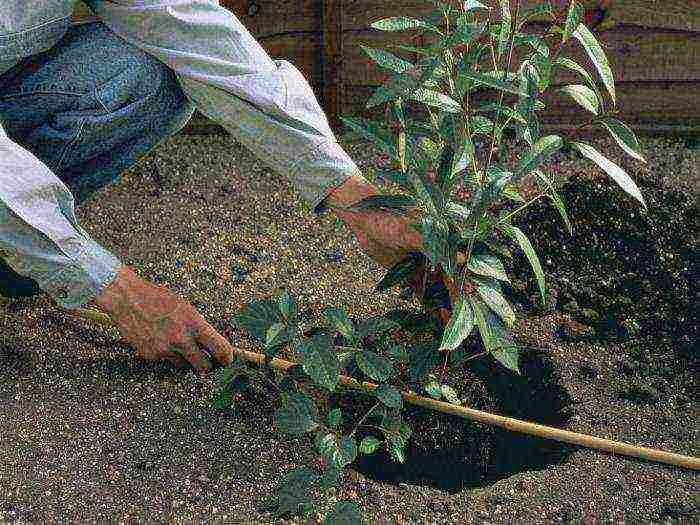
Propagation of hydrangeas by seeds
In order not to miscalculate with the cultivation of the plant, first it is better to make sure how the hydrangea seeds should look like. For them, you need to prepare a nutritious and loose substrate. The grains are placed in the soil about half a centimeter deep and sprinkled with a thin layer of substrate. After that, the soil must be moistened by spraying with water from a spray bottle. The container with seedlings can be covered with glass or foil for a month and a half. The room temperature should be kept at fourteen to twenty degrees Celsius. Only in this case you can count on the emergence of seedlings.
Third step: choose a place on the site
In deciding how to care for a hydrangea in the country, the choice of a planting site is almost the most decisive. The bush plant will show abundant flowering and good growth only in an area with good lighting. In extreme cases, partial shade can also become a compromise. But the sun's rays should still fall on the plant for most of the day.
Colored varieties need a little shading at noon. The best place will be a flower bed in the country, where the sun's rays fall only before lunch. After that, the hydrangea should be in the shade. It is also important that the bush is protected from drafts.
Fourth step: plant hydrangea in the ground
Planting and caring for hydrangeas in the country usually begins in early May or late September. First, the pits are prepared by digging depressions in the area. They should be fifty centimeters in diameter and one meter deep. It is also important to keep the spacing between the excavated grooves. Usually it is made at least one and even one and a half meters.
The soil mixture is poured into the prepared pits. It should include two parts of leafy land, two parts of humus, one part of peat and one part of sand. Experienced flower growers add fertilizers to it. For ten kilograms of humus, they take twenty grams of potassium sulfate and urea, as well as sixty grams of granular superphosphate.

When planting, much attention is paid to the root collar. It should protrude slightly above the soil.Otherwise, during its subsequent settlement, an important part of the plant will be underground. After planting, the soil must be tamped and watered well. How to care for hydrangea in the country after this? For the first time, it is protected from the hot daytime sun. For the warmest hours, the seedlings are covered with agrofibre, which perfectly reflects at least part of the rays. It is also necessary to protect the hydrangea from strong gusts of wind. To do this, the trunk is fixed to a peg, tied up with some kind of tape.
Step Five: Watering Regularly
Hydrangeas are exactly the kind of plant that loves water very much. It is not for nothing that its Latin name contains the part “hydra”. Water these flowers abundantly and every week. Pour two large buckets of water under each bush. This is about fifteen to twenty liters per one-time consumption for each instance. Reduce watering frequency in rainy weather. The previous irrigation regime can be resumed if the last rainfall was a week ago. To improve resistance to infections and improve the growth of hydrangea bushes, it is recommended to add a pinch of potassium permanganate to the water for irrigation.
Sixth step: periodically loosen the soil
Now let's move on to how to care for a hydrangea in the country during its active period. During the season, you need to loosen the soil around the plant twice with a depth of about six centimeters. This is best done after weeding and watering. Typically, long-toothed hoes are used to provide airflow to the roots.

To retain moisture, flower growers practice mulching the trunk circle. It is recommended to use old sawdust, pine needles, peat and moss. They will save moisture and get rid of weeds. Each layer should be about five centimeters thick. For example, if mulch is covered in spring, then it will perfectly retain its properties until autumn. Experienced growers prefer this particular method of soil care. Because it is guaranteed to free you from constant loosening and weeding. It will only be necessary to water and feed.
Seventh step: color the hydrangea
This point is not required for implementation, but it has a place to be. But often caring for hydrangeas in the garden and in the country involves this action. It is surprising that, depending on the chemical composition of the soil, the flowers of this plant will change their color. This sometimes does not work with specimens that have white petals. But with the rest, you can freely experiment.
The inflorescences will acquire a pink tint if acidity is increased in the soil. For this, gardeners usually apply phosphorus fertilizers. You can water the bushes with a solution of aluminum alum. Hydrangea pink petals can turn purple and whites blue. Usually, forty grams of a substance is taken for ten liters of water. Pour two buckets under each bush. The procedure is repeated after ten days.
Eighth step: prune the plant
If the plant was planted in spring, then pruning should be done in the fall. After summer, all faded parts must be removed. They cannot be left for the winter. Caring for hydrangeas in the spring in the country also includes pruning. The best time for this procedure is March. As a rule, a maximum of ten to twelve strong and healthy shoots are left.

If the bush is already old, then it can be easily rejuvenated with strong pruning. The root system of hydrangeas is especially powerful, so this will only benefit the plant. Initially, the young growth will be lively and strong. Usually all trunks are trimmed to such an extent that stumps are about six centimeters high. Later, fresh and young shoots will appear from them, which will delight with large caps of flowers next season.
Ninth step: feed
In general, a hydrangea that is planted in a new hole does not need feeding for two years. If this time has already passed, then fertilizer should be applied four times a year.
How to care for hydrangea in the country in the early spring to stimulate growth? For this, a special solution is used. For ten liters of water, 25 grams of urea, 35 grams of potassium sulfate and forty grams of superphosphate are taken. Instead, you can use complex mineral supplements with trace elements. They take about thirty grams per ten liters of water.
The second feeding is carried out during the period of bud formation. Fifty grams of potassium sulfate and eighty grams of superphosphate are added to one square meter of soil under the bush.
The third feeding is done in the summer, in July. Ten liters of mullein solution are poured under each bush. Sometimes a liquid infusion of any herb is used. In any case, ten parts of water are taken for part of the additive.
For the fourth time, hydrangea is fertilized in August. The recipe can be taken the same as for the third feeding.
It is important to remember that lime for caring for hydrangeas in the country in spring, summer and in general at any time is categorically not suitable! Such fertilization can completely destroy the entire plant.

Tenth step: cover the hydrangea for the winter
Treelike hydrangea does well without shelter. But the paniculate and large-leaved species can no longer survive without it in winter. To prevent the roots from freezing, hilling is carried out with rotted manure. Some growers equip a fifteen-centimeter protective layer of dry leaves, needles, moss and peat. After that, agrofibre is laid on it. In such "clothes" the hydrangea overwinters well.
It is important to remember that young plantings of any variety need to be wrapped up for the winter. Because they are not yet strong enough to fight the frost. The coating is still the same - leaves and agrofibre.
Now you know how to care for a hydrangea in the country, so that it pleases everyone with its large and bright inflorescences.
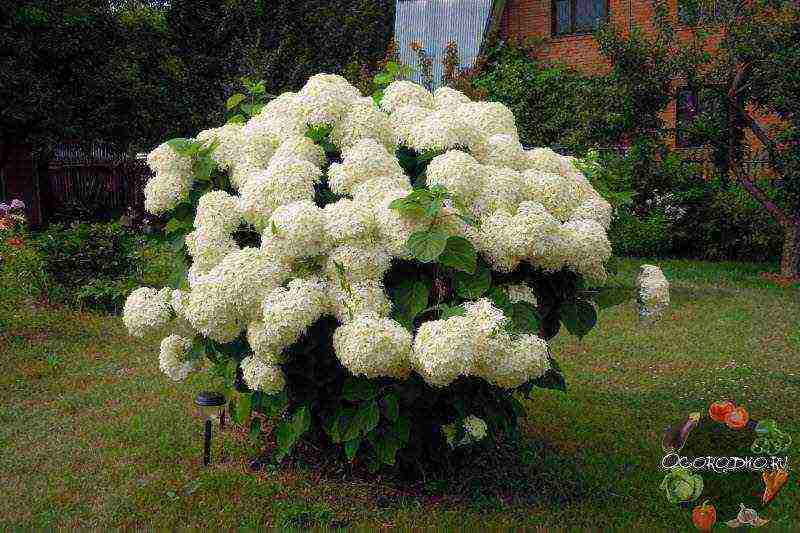
Hydrangea, planting and care are of no small importance when growing, since an unsuccessfully chosen place and soil composition of the soil can lead to diseases and poor development, in some cases death. In addition, after planting, you need to take care of the shrub correctly in order to achieve lush flowering and healthy growth ...
Site selection and soil preparation
When to plant a hydrangea? The best time for planting is spring, the moment when the earth thaws, the buds have not yet blossomed, and autumn is in the month of September. When choosing a place for an ornamental deciduous plant, keep in mind that it is better to plant a hydrangea in the shade or partial shade, since the bright sun causes slower growth, as a result of which the inflorescences become smaller.
Some types of hydrangeas can be grown in open, sunny areas, but this requires abundant watering. It is advisable to protect young shrubs from the bright sun and strong winds. It is not recommended to be placed under trees that strongly absorb water.
The soil for hydrangea should be well-drained and moistened, consisting of a balanced mixture of humus, leafy soil, peat chips, river sand (2: 2: 1: 1). Regardless of the type and variety of hydrangea, remember that lime in the soil has a negative effect on development. The soil should have a Ph level of about 5.0.
Planting hydrangeas outdoors
In the northern regions of the country, it is preferable to plant hydrangea in open ground in the spring, in the southern regions, including the Kuban, the procedure is carried out in the fall. It is recommended to equip a planting hole for a beautiful shrub, the dimensions of which are 0.4 m in diameter and a depth of 0.4-0.5 m.When planting, be guided by the size of the root system, if too large, increase the volume of the hole. It is worth noting that the roots of the hydrangea are quite branched.
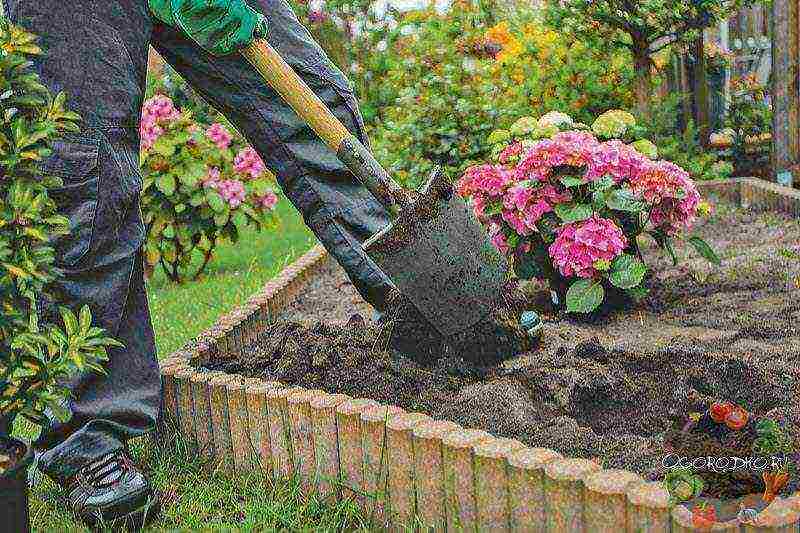
choosing a place and planting a hydrangea with a closed root system - in the photo
It is necessary to introduce the prepared soil mixture into the pit and make a small mound, on which the seedling is then carefully placed and the roots are straightened, they fall asleep without deepening the root collar, which should be flush with the soil.A slight deepening is permissible, but not more than 20-30 mm; too deep landing can subsequently lead to decay of the neck.
The soil in the near-trunk zone must be well tamped. Watering the hydrangea after planting is mandatory, it is necessary that the water seeps well to the depth of the roots of 30-40 cm. Watering is best done in the hole next to the plant.
Top dressing and mulching as the basis of care
To retain moisture after planting in a permanent place, the hydrangea is mulched in the trunk circle. Mulch also inhibits the growth of weeds and protects the roots from overheating. Peat chips, wood chips or bark are used as a mulching material, having a uniform layer of 8-10 cm.
Mulch will decompose over time and become part of the soil, slightly acidifying it. Mulch is best laid in late spring, when the ground is already well warmed up but still damp.
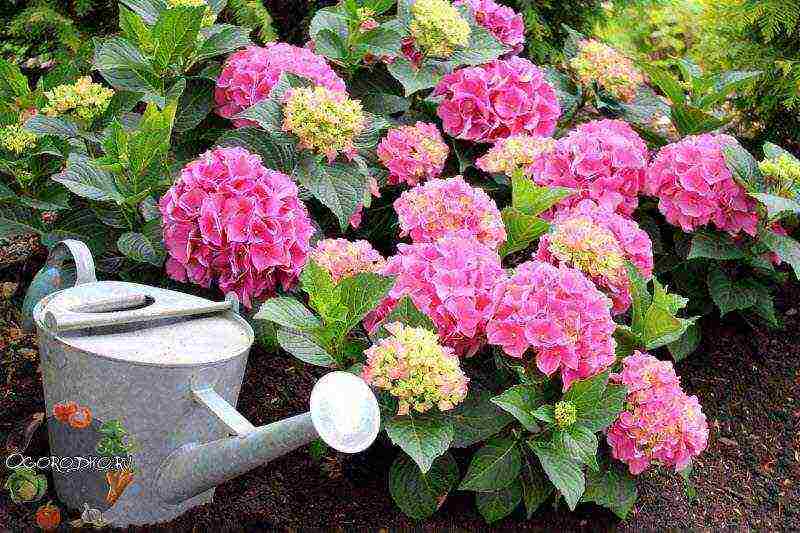 watering hydrangea - pictured
watering hydrangea - pictured
So that the shrub grows well and pleases with abundant flowering, the garden hydrangea is fertilized when planting, then in the spring in the third decade of May or in early summer - early June. Use a solution of mullein or chicken droppings diluted 1:10 with water. Do not forget to fertilize with a complex of mineral fertilizers or add at least the most basic components - 20 grams of superphosphate, 10 grams of potassium nitrate and urea each. Subsequent feeding of hydrangea is carried out with an interval of 17-20 days and ends at the end of July, so that the young shoots have time to woody by the winter period.
For strong and flexible shoots, an ornamental shrub is watered with a solution of potassium permanganate of a weak pink color. In addition, garden stores sell special fertilizers for hydrangeas, which include magnesium and iron, which the plant needs.
 mulching hydrangea with wood chips - pictured
mulching hydrangea with wood chips - pictured
Panicle hydrangea, large-leaved and ground cover are predominantly pinkish, creamy colors that can be changed if desired. The color of the hydrangea is directly related to the acidity of the soil. If the soil is slightly alkaline, then the flowering will be pink and crimson; on acidic soils, the hydrangea blooms with blue flowers.
To obtain blue flowers in alkaline earth, the shrub is watered with solutions of iron salts. To get a more intense blue color, rusty metal cans should be buried under the hydrangea.
Pruning hydrangeas - continue to groom
Do I need to prune a hydrangea and how to do it? In order for the care to be correct, it must be remembered that pruning of hydrangea large-leaved, serrated, prickly, Sargent, liana-shaped, oak-leaved is carried out taking into account the fact that flowers appear on the shoots of the second year, which means that you need to cut off old branches and weak ones, to strong buds.
Pruning hydrangea paniculate and tree-like involves removing old and faded shoots, also weak. At the same time, experienced gardeners do not recommend removing a large number of shoots at the same time, it is better to stretch the procedure for a year or two so that the plant does not lose strength and does not die from excessive cutting operations. The main branches, as a rule, are not touched, only those that are bad and grow inside the bush are cut off.
 autumn pruning hydrangea - pictured
autumn pruning hydrangea - pictured
You can prune hydrangeas in spring and autumn, but it is preferable in the fall, since sap flow slows down, and a haircut will contribute to lush flowering in spring. In the spring months, improper pruning can slow down growth and delay flowering. In addition, in the spring, the processes begin to actively start at the shrub, juice is released during pruning, so be careful not to harm the plant. In spring, pruning is best done as early as possible, before the buds swell and constant heat is established.
Pruning hydrangeas for the winter is carried out as usual, with only one difference - it is better not to touch young shrubs and let them overwinter without surgery, otherwise you risk ruining the plant. Hydrangea, planting and caring for which is not at all difficult, will certainly delight with its lush flowering, if you suddenly decide to grow an unpretentious plant in your garden.
Gotense: related photos
Hydrangea is a flowering shrub and a favorite of gardeners. It blooms from mid-summer to late autumn, covered with huge inflorescences, behind which no leaves are visible.
There are several dozen types of hydrangeas, and all are deciduous shrubs and vines. At home in the subtropics, plants reach 4 meters in height, but as they move north, their sizes become more modest. Hydrangea in a garden of a temperate climate looks like a small bush with a height of a meter and a half.
In recent years, flower growers have been promoting a highly decorative plant further north, breeding winter-hardy varieties and practicing new technologies for winter shelters. The cultivation boundary runs along the middle lane.
In the middle lane, you can grow 3 types of hydrangeas:
- tree-like;
- paniculate;
- large-leaved.
Paniculata is a large bush or tree on a trunk with huge white, pink, burgundy or lilac inflorescences in the form of a pyramid with a wide base. A feature of the species is the ability of inflorescences to change color during the season. They can be white at the beginning of flowering, then turn pink, and by autumn they become transparent light green.
New varieties of plants appear every year. In the gardens of our country, the Grandiflora variety with white inflorescences reaching a quarter of a meter in length is more common. In this group, Kyushu is worth noting as the only cultivar with a scent.
The flowering of this species is long lasting. Mass flowering begins in July, but there are early varieties blooming in June.
Tree-like in our climate, it is grown in a wide bush about a meter high. Its ball-shaped inflorescences reach a diameter of 25 cm. The most popular variety is Annabelle, with white round caps of inflorescences.
Large-leaved or garden - the plant is sold in garden centers as a potted plant, we see it in flower beds, coming to rest in Gagra, Sochi and other resort towns of the Black Sea coast. It is popular in southern Europe - this plant is not found in a rare garden in Spain or France.
In hydrangea large-leaved flowers are collected in round inflorescences of large, up to 3 cm in diameter flowers. The diameter of the inflorescence in the best varieties reaches 20 cm. The flowers are snow-white, pink or blue, open from mid-summer to September.
The subtropical plant, through the efforts of enthusiasts, moved north and is grown in the Moscow region only under winter shelters. Hydrangea cannot be called a plant for beginners, as it requires careful maintenance and some special knowledge.
This species is easier to grow in the garden in a container culture, bringing the plants into the room for the winter at a positive temperature.
Preparing for landing
All types of hydrangeas love acidic soils, so soil preparation begins with the introduction of sour high-moor peat into the planting pit. You need to stock up on needles and bark of coniferous trees for mulching.
Planting pits for hydrangeas are prepared before planting in the spring. The size of the pit depends on the size of the seedling. The root system should fit freely in the hole with the roots spread out.
Seedlings of hydrangea paniculata and tree-like are purchased in garden centers, therefore preparation for planting consists only of choosing a place and digging a planting pit.
These species love light and look great as tapeworms. For them, they choose the most prominent place - on the lawn or at the entrance to the building. The main thing is that it is in the light and protected from the winds.
Treelike hydrangea can grow in partial shade, but it does not tolerate strong shading.
Before planting, the seedling is taken out of the package and the roots are soaked for several hours in warm water or in a weak solution of trace elements. This technique speeds up survival and the plant will bloom faster, possibly already next year.
Large-leaved hydrangea is demanding on soil and moisture. The place for planting is chosen carefully, since the peculiarities of the microclimate affect the overwintering and the possibility of flowering. It happens that a plant grows in one place for years and does not bloom, but transplanted to a lowland, where more snow accumulates in winter, and is always wet in summer, it begins to bloom.
The area for these hydrangeas should be lit. In partial shade, the plant will bloom later and not as abundantly as in the sun.
For a large-leaved plant, planting begins in mid-May. When choosing a time for planting specimens that have overwintered indoors on flower beds, you need to keep in mind that if there are late spring frosts to 0 and below, the flower buds will die, and the plant will not bloom this year.
When preparing for planting in open ground, it is important to choose a large-leaved hydrangea variety. Recently, remontant varieties have appeared in foreign catalogs, blooming on the growth of the current year. They are suitable for growing in the middle lane, as they are guaranteed to bloom every year.
Treelike and large-leaved hydrangeas reproduce by layering and cuttings. Cuttings are cut during flowering in early July, cutting off the young tops of the lateral shoots.
Cuttings are rooted in a mixture of sand and high-moor peat using green cuttings. Roots are formed at a temperature of 16-210C after 3 weeks.
All kinds of seeds can be bought in stores. They are sown in February in bowls with acidic soil: the purchased tofogrunt "Hortensia", "Azalea" and "Cypress" will do. After sowing the seeds, the substrate must not be allowed to dry out, so the bowls are covered with glass and the soil surface is moistened daily from a spray bottle.
Seedlings dive into pots, and with the onset of warm weather they are transplanted into the garden to a permanent place. Propagating hydrangea by seed is troublesome and unreliable, since there is no guarantee of compliance with the grade.
Planting hydrangeas
Hydrangeas are planted only in spring. Compost or humus is added to the pit, heavy soils are loosened with sand, and clay is added to the bottom of the pit on the lungs.
Paniculata
When planting, the garden soil is abundantly filled with organic matter and mineral fertilizers, given that the plant will remain in one place for several decades. The pit is prepared voluminous, since the roots of the plant will grow strongly over time. Fertilizers are poured onto the bottom of the pit and mixed with soil, then covered with a layer of unfertilized soil.
When laying a hedge, they do not dig holes, but a meter wide trench. There should be a distance of 2.5 m between the seedlings. If the hedge needs to be obtained earlier, then the plants are planted every meter, and when they grow, they are thinned out.
In seedlings, before planting, the tips of the roots are cut off so that they branch better, and the one-year growth is shortened, leaving 2-3 pairs of buds on each branch. After planting, the trunk circle is poured with water and mulched with peat, needles or pine bark.
Sometimes it is important for landscape design that the hydrangea bloom quickly in the open field. Then they acquire a 5-year-old specimen and plant it in a pit 70 cm in diameter and 40 cm deep. The plant will bloom in the year of planting if transplanted with a clod of earth.
Large-leaf
It is planted in the spring in planting pits 30x30x30 cm. The distance between adjacent specimens is 100 cm. The pit is filled with fats and organic matter and fertilizers are mixed with the ground. The roots of the seedling are shortened a little, the root collar is not buried. After the garden planting hydrangea ends, the shoots are cut off, leaving 2 pairs of buds. The bush is poured with water and mulched with needles, peat or bark.
Tree-like
Planting a tree hydrangea in open ground begins in early spring, since the plant is not afraid of cold weather.Seedlings overwintered in the nursery can be planted immediately after the soil thaws, and grown in greenhouses - only when the threat of frost has passed. The pit should be spacious. On sandy soils, clay is laid on the bottom so that the water stagnates slightly.
For this species, it is important that the groundwater does not reach the roots, therefore, if their height exceeds 1.5 m, then the seedling is planted at the highest point of the site. Add 50 g of phosphorus, potash and nitrogen fertilizers and half a bucket of humus to the pit. Fresh manure cannot be added. If the seedling has a pronounced stem, then it is planted to the level of the bark neck. It is better to plant seedlings in the form of a bush with a slight deepening.
Hydrangea care
Caring for different species will vary. The only common thing is that all species are in dire need of watering. No wonder the second name of hydrangea is hydrangia, which translates as "a vessel with water".
Paniculata
In autumn, plants are fed with complex fertilizers, and in spring with urea: 2 tbsp. l. on an adult bush, dissolve in 2 buckets of water and water. This allows them to develop and form large panicles.
During the growing season, the plant can be fertilized with slurry, but if you overdo it with organic fertilizing, then the branches of the bush can break off under the weight of the inflorescences.
It is important to form the shrub correctly. Gardeners do not like to prune branches, but in the case of panicle hydrangea without strong pruning, you can not wait for abundant flowering.
Pruning rules:
- All inflorescences are cut off in autumn.
- In the spring, all weak and frozen branches growing inside the bush are cut out on the ring.
- In the spring, the one-year growth is shortened, leaving no more than five pairs of buds on each.
Such pruning contributes to the fact that every year the bush will bloom more luxuriantly. A five-year-old specimen, with good care, will delight the owner with several dozen panicles, and a twelve-year-old specimen with several hundred!
The plant tolerates wintering in the garden without shelter. It is enough to mulch the trunk circle with humus for the winter.
The plant lives in the garden for 50 years or more. A specimen over 20 years old can be rejuvenated by cutting the bush into a stump. But even such pruning will not prevent the plant from blooming in the same year.
Tree-like
Pruning is aimed at reducing the number of inflorescences - then the remaining ones will be larger. The plant blooms at the growth rate of the current year. In early spring, all shoots are shortened by more than half, leaving 2 pairs of buds. Frozen and weak branches are cut into a ring. In the fall, dried inflorescences are cut off.
This is the most frost-resistant species. He is left to winter without shelter. Saplings brought from warm regions and not yet adapted are slightly spud and slightly covered with spruce branches for the winter.
The trunk circle is constantly kept mulched - this allows you to keep the soil moist. Every spring, humus is added under the bush, and in the fall, several buckets of compost - such a litter in winter will protect the roots from frost.
In order for the bush to develop well and bloom profusely, it must be fed during the season. In the spring, fertilizer for hydrangeas or any complex fertilizer, including nitrogen, phosphorus, potassium and trace elements, is scattered around the bush.
The second feeding is done during budding. At this time, only phosphorus and potassium are needed. On each trunk circle, pour 50 g of superphosphate and the same amount of potassium. From this time on, it is impossible to add nitrogen fertilizers and humus, since a plant overfed with nitrogen does not overwinter well.
To make the shoots stronger, they spray the bush three times in the spring and shed the soil under it with potassium permanganate. Manganese enhances the strength of the branches, which without feeding can break under the weight of flowers.
Large-leaved
Large-leaved hydrangea is not pruned. It blooms on last year's branches, so it is important to keep them intact. An exception will be the few remontant varieties blooming on the growth of the current year.
In late autumn, the plant is tilted and attached to the soil with metal pins.Shoots are placed not on bare soil, but on boards or pine branches. Spruce branches or fallen leaves are placed on top.
In early spring, after the threat of frost passes, but not earlier than mid-April, the shelter is removed. They try to do this on a cloudy day or in the evening so that the shoots do not end up in the bright sun and do not get burned.
So, there are several features of care:
- The plant is moisture-loving and the soil should not dry out.
- Mandatory trimming.
- Overfeeding with organic matter will lead to the fact that the bush, instead of flowering, will begin to grow in breadth.
- Hydrangea needs a winter shelter like rose bushes. If it freezes, then there is no need to despair, as the plant will recover.
- All types of hydrangeas are not affected by pests and hardly get sick.
- To change the color of the flowers of pink and lilac large-leaved hydrangea, it is enough to change the acidity of the soil.
Due to the long and spectacular flowering, lasting until cold weather, hydrangeas are indispensable for creating flower beds. They are planted singly, in groups and in the form of a hedge. Many new varieties are bred, many of them can winter in the garden, so each grower can choose plants to his liking and decorate the plot with them.
Editor Flowers and shrubs 6242
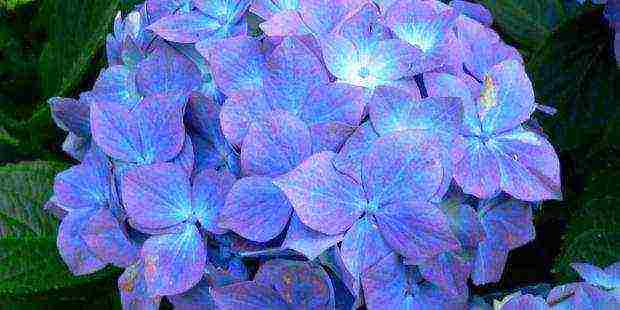
Even those who have never been gardening in the country always pay attention to such beautiful and bright flowers as a luxurious hydrangea. This flower will really easily decorate any garden, give a lot of pleasant emotions and good mood. It needs minimal care, and planting does not take much time. The plant has more than 30 varieties, but the most common is tree hydrangea, for example, annabelle. It looks like small shrubs, but some varieties are liana-like. The flowers themselves are small and collected in large inflorescences. They do not have a scent as such, but this does not prevent the plants from being popular with both experienced and novice flower growers.
Types of hydrangea
Garden hydrangea is divided into tree hydrangea, paniculate and large-leaved.
Hydrangea
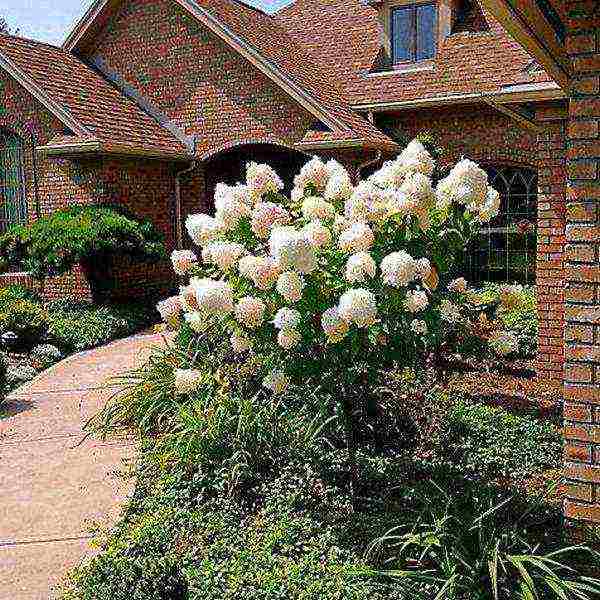
These are low bushes (sometimes reaching 1.5 meters) with large leaves and inflorescences. It blooms almost all summer until late autumn. Shrub maintenance is minimal. Treelike hydrangea is really unpretentious, and also calmly tolerates the neighborhood of roses and lilies. The most famous species are:
- hydrangea anabel;
- sterilis;
- grandiflora.
Hydrangea paniculata
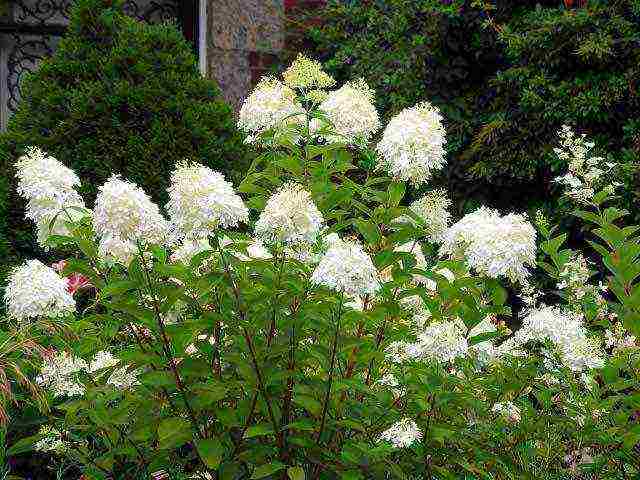
This species is distinguished by the shape of its inflorescences. If the tree-like hydrangea with its flowers looks like huge balls, then these shrubs are more reminiscent of oblong panicles of lilac. The bush grows up to 3 meters in height, planting is most effective in spring. The plant is very demanding on soil moisture, but in general, caring for it is the same as for tree hydrangea. Popular varieties are bobo hydrangea and matilda.
Large-leaved hydrangea

This species reaches a height of 1.5 meters, and blooms only at the end of summer. Shrub care needs a special one. The large-leaved hydrangea rarely survives during cold winters, so this plant is rarely seen in our latitudes. However, in the south, it is common, since it is much easier to care for it there. Famous varieties are Expression and Red Centiation.
How to plant correctly
Proper planting allows you to grow a healthy plant and enjoy its flowers for more than 10 years. Few people are engaged in this flower in the city, but why not take the opportunity and plant it in the country? Moreover, it does not need careful care, and it will delight you with its beauty for a very long time. As for the varieties, you can choose any - annabelle, bobo or grandiflora. Treelike hydrangea is slightly different from paniculata in ways of care, but by and large the difference between them is only in flowering.
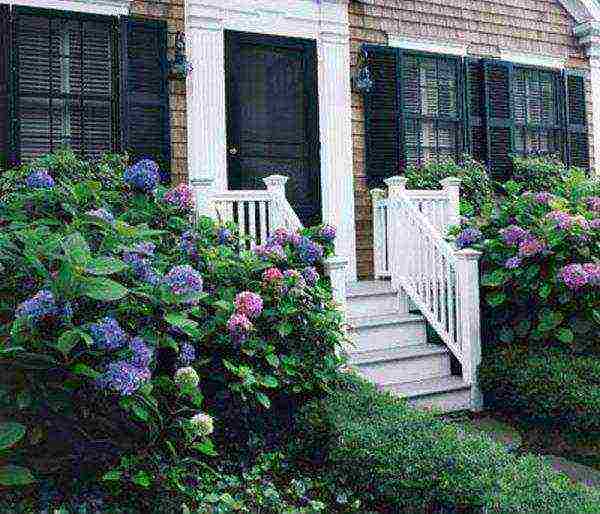
First of all, you should decide on the place and time. Ideally, planting should take place in the spring, but some varieties can easily take root in the fall. Experienced gardeners recommend planting hydrangeas in the shade, as the plant does not like sunny colors. In addition, the sun slows down its growth. Let the sun hit only the top of the plant, and the bush itself remains in the shade. Everyone can find such a place in their dacha and take minimal care of the bush.
The soil near the roots must be constantly fluffed. If there is no time for this, then mulch can be added to the soil during planting. Provided that the roots are already strong enough, it is allowed to plant it even in late autumn. Planting large-leaved hydrangea in the country is the same as for other species.
It's important to know:
- Planting provides for good soil fertilization;
- You can easily create a hedge from this shrub. For this, the distance between seedlings should be no more than a meter;
- If the plant is planted in the fall, then usually its roots are shortened by cutting off young shoots.
Plant care
In order for the care of the hydrangea to be correct, it is necessary to pay enough attention to feeding. For this, it is better to choose mineral fertilizers or urea. In dry weather, hydrangea must be watered 2 times a week. If it was raining, then you can water it once. Water for irrigation is usually taken from rainwater, sometimes lemon juice or vinegar is added to it to prevent chlorosis.
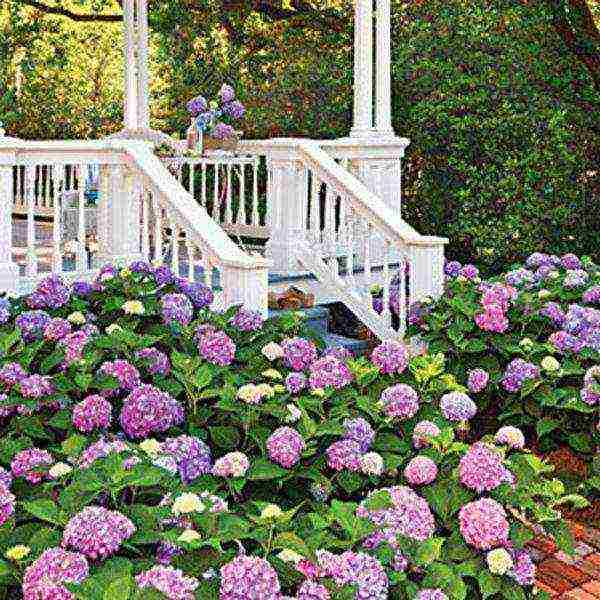
Cutting the hydrangea is also important. The plant only begins to bloom a few years after planting, so as soon as this happens, all flowers need to be cut. This should be done with a garden pruner so as not to damage the buds. Thus, all forces will go to strengthen the bush itself.
If a large-leaved hydrangea was planted in the country, then it is worth remembering that closer to winter, flower growers begin to have problems with its shelter. Proper care of this type of hydrangea is very important, otherwise it will simply die. In this case, you need to know that all inflorescences appear on last year's shoots and it is they who must be kept from freezing. It is best to cover the plant by pinning the shoots to a non-woven warm material spread on the ground. Cover with the same material and cover with a mixture of earth and peat. It is necessary to open large-leaved hydrangea not earlier than the end of May.
Cuttings
It is recommended to cut the shrub at the beginning of the movement of the juice, but before the buds appear. This allows the cuttings to root better in the future. Treelike hydrangea is pruned earlier than panicle hydrangea, as it begins to develop faster after winter. 3-4 buds should be left on the shoots. Then they need to be cut so that each has several nodes. Make a straight cut above the upper kidney, and obliquely above the lower one. The cuttings are dug into the soil, deepening the lower bud by 4 cm. The panicle hydrangea is cut in a completely different way. Usually last year's cuttings are cut and then planted in a greenhouse. They can only be planted in open soil in summer.
You can also cuttings in summer, planting them in the ground in July. But this method is not very good, since such plants often die in winter. If you prune cuttings in the fall, then it is better to plant them in special garden pots, having previously treated with a solution of foundationol. All pots should be placed in plastic bags and placed on a windowsill. Plants need to be protected from the cold all winter. In addition, from time to time they should be ventilated, and in the spring, if there is no sun, they should be taken outside. Planting cuttings in open ground in the country takes place after determining the state of the plant. Such care involves a lot of trouble, so cuttings in the fall are not very popular with flower growers.
There is a way to propagate shrubs by layering. To do this, choose a branch that grows in close proximity to the soil. Then all the leaves are cut off on it, and the bark is peeled off from below.The branch is lowered to the soil, pinned and covered with earth. It is important to remember that the end of the branch must remain in the open air. You can cut off a new stalk only when it is well rooted and gets stronger.


